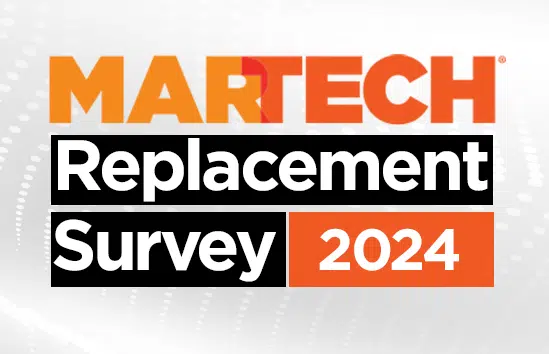Business is a little sluggish for a number of martech vendors. They will tell you so themselves (just keep reading). Put the blame on interest rates. Put the blame on the well of VC money that is running pretty dry. Put the blame on pandemic-era spending sprees, during which many companies filled in the gaps in their tech stacks.
But save some blame for a maturing market. Can you think of a lot of companies that need a CRM or marketing automation platform today but don’t have one?
Earlier this month, MarTech contributor Gene De Libero wrote about the lack of net-new deals available to martech vendors as the category reaches saturation. Many industries go through this. It is often easier to sell something when no one has it but many people need it. It gets a little harder once everyone has it.
The good news for martech vendors is the SaaS business model revolves around recurring revenue from subscriptions, so there’s a steady flow of cash coming from the customers.
The bad news is that growth in a mature market becomes more focused on a few strategies, including cross-sell, upsell and competitive displacement.
It’s hard to displace a competitor when you’re talking about martech applications that sit at the center of the stack. Migrations are expensive, time consuming and introduce a significant amount of risk. It’s the incumbent’s advantage. When you change the apps at the center of the stack, you end up making changes throughout the stack. You can feel the ROI slipping away in the process.
Yet despite saturation, interest rates, vanishing VC cash and more, major martech vendors are bringing in a lot of money. I mean an awful lot of money. (Though not, in some cases, as much money as Wall Street wants.)
I examined the earnings results from four SaaS martech vendors to better understand where they’re finding success and where they’re seeing challenges. The following is based on earnings for the first quarter of calendar year 2024, which for some companies is fiscal year 2025.
Dig deeper: 14,106 martech tools reveal 3 trends you should master
HubSpot’s Q1 2024 results
In summary:
- Total revenue: $617.4 million, up 23% compared to Q1 ’23.
- Subscription revenue: $603.8 million, up 23% compared to Q1 ’23.
- Professional services and other revenue: $13.6 million, up 15% compared to Q1 ’23.
Because HubSpot is a favorite of smaller businesses, it’s a little easier for the company to add net new customers. Businesses are born, then they reach the point in their growth where they need a CRM. HubSpot counted 216,840 customers as of March 31, 2024, up 22% from one year earlier. It added 11,700 net new customers in the quarter, including nearly 800 customers from its acquisition of Clearbit.
Where things are going well for HubSpot
Downgrade rates are improving. HubSpot was having a problem with customers downgrading their HubSpot product tiers (most likely to save money). That stabilized in Q1.
Free users are upgrading to starter products. These customers are positioned to keep climbing the HubSpot ladder as they grow.
Sales Hub is gaining popularity and customers are consolidating on HubSpot. The different hubs mean different entry points for customers, which can then add additional hubs. More than 35% of HubSpot’s Pro plus customers use three or more hubs.
Where things are going less well for HubSpot
Customer upgrades are a challenge. While downgrades are stabilizing for HubSpot, getting people to spend more to upgrade remains a difficult task.
Gross retention held in the high 80% range in Q1, and net revenue retention was 101% (102% if you remove the impact of Clearbit in the quarter). HubSpot’s average subscription revenue per customer was $11,447 during the first quarter of 2024, up 1% compared to the first quarter of 2023.
When customer upgrades return, those numbers should rise in response.
What they said
In Q4 of 2023, HubSpot saw deals with customers closing more quickly than in previous quarters. The hope was that would continue into 2024.
“Instead, we saw a return to higher scrutiny of budgets, more decision makers getting involved and a need for more demos and proof of concepts before signing on purchase decisions. At the top of the funnel, we saw lead flows shift away from higher quality inbound and partner-sourced leads to lower quality rep source leads.”
Yamini Rangan CEO, President & Director, HubSpot
Dig deeper: HubSpot buying B2B data source ClearBit
Salesforce’s Q1 2025 earnings
In summary:
- Q1 revenue: $9.13 billion, up 11% year-over-year.
- Subscription support revenue: Grew 12% year over year.
Where things are going well for Salesforce
Big customers are buying multiple products. Nearly half of the company’s top 50 wins in the quarter included six or more Salesforce clouds.
Data Cloud is gaining in popularity. Salesforce Data Cloud was included in 25% of its $1 million or more deals in the quarter. Salesforce added more than 1,000 Data Cloud customers for the second quarter in a row.
Certain verticals and geographies are strong. Salesforce executives cited Japan, India and Canada as areas where the company performed well in early 2024. The public sector and financial services sectors also performed well.
SMB products are growing. Salesforce added 2,300 new customers for its Starter and Pro Suite products for SMBs in Q1.
Where things are going less well for Salesforce
Professional services are struggling. If a customer is looking to save money, dropping the CRM platform is a drastic move. Less drastic is cutting back on consultants. Salesforce’s Q1 results were at the lower end of the company’s guidance and pressure on professional services was cited as a reason why.
Certain verticals and geographies are weak. Salesforce said growth was constrained in the United States, parts of Latin America and EMEA. The high tech, retail and consumer goods industries were also constrained.
What they said
This sounds familiar.
“We continue to see the measured buying behavior similar to what we experienced over the past two years and with the exception of Q4 where we saw stronger bookings, the momentum we saw on Q4 moderated in Q1. And we saw elongated deal cycles, deal compression and high levels of budget scrutiny.”
Brian Millham, President, Chief Operating Officer, Salesforce
Dig deeper: Salesforce predicts lower growth as CEO focuses on AI’s problems
Zeta Global’s Q1 earnings
In summary:
- Revenue: $195 million, an increase of 24% year over year.
- Raised 2024 full-year guidance by $25 million to $900 million.
Where things are going well for Zeta Global
There’s a CDP replacement cycle. First-generation customer data platforms (CDPs) lacked features like AI and struggled with data governance and with omnichannel applications. Zeta’s strength in these areas makes it a good option for customers looking to upgrade.
Certain sectors are bouncing back. Zeta saw growth in the automotive and insurance sectors, something it didn’t expect to see for another quarter.
Success with agency holding companies. Zeta is now working with the top five advertising agency holding companies, which represents hundreds of brands. There’s cross-sell and upsell opportunities available at these companies and Zeta says its data makes the agencies look good and win business.
What they said
“Our value proposition is resonating with chief marketing officers as they seek new tools to capitalize on the power of AI and replace legacy marketing clouds with first-generation CDPs that are not delivering on their promises.”
Scott Schmitz, Senior Vice President of Investor Relations, Zeta Global
Semrush Q1 2024 earnings
In summary:
- Revenue: $85.8 million, up 21% year over year.
- ARR: $354.2 million, up 21% year over year.
- Paying customers: 112,000 as of March 31, 2024, up 10% from a year ago. SEMrush has 1.125 million free active users.
- Dollar-based net revenue retention: 107%
What’s going well for Semrush
A new enterprise offering. Semrush soft launched an enterprise product in October 2023. The average revenue per user (ARPU) for the enterprise product tends to be 10 to 15 times the company’s ARPU.
AI innovation. Semrush structured its product offerings to make AI features available in its higher-cost tiers, giving customers who want to use AI more incentive to upgrade.
International growth. Almost half of the customers who adopted Semrush’s enterprise product since October are international companies.
SMB market is strong. The bulk of Semrush’s new customers come from SMBs and the company expects that market to remain strong.
What they said
“I would say we don’t see any kind of significant changes with macro for all businesses. In all segments, we believe it’s still challenging.”
Brian Mulroy, Chief Financial Officer, SEMrush
3 takeaways on martech vendors and their performance
Here’s what I take away from this exercise.
This looks like a maturing market. Competitive displacement becomes important to growth in a mature market, and it will always be a challenge. And there is almost always some industry sector or geographic region experiencing softness. We may never see the growth rates we saw in the early days of martech. But these companies continue to rake in cash, regardless of how their performance is perceived by Wall Street.
Innovation leads to growth. Vendors that innovate will find ways to generate revenue. Zeta is offering more than a previous generation of CDPs could offer. Salesforce is investing heavily in AI and in its Data Cloud. Semrush developed a tool for enterprise teams. HubSpot added more hubs from its humble Marketing Hub beginnings. When vendors innovate, it’s just flat-out easier to market and sell the products, and it makes it easier to displace incumbent vendors.
Wall Street is not the real world. When a market matures and the growth rate slows, businesses do things to appease Wall Street. They cut jobs. They acquire businesses. They’ll do anything to make the revenue and profits go up and the costs ultimately go down. Forget about market saturation, VC cash and all of that. These companies are bringing in significant revenue and adding customers. They’re going to be just fine.


